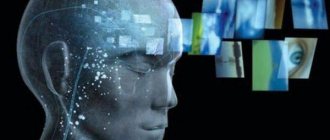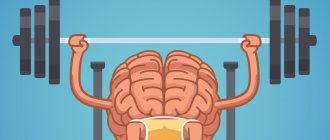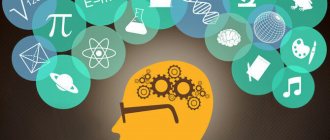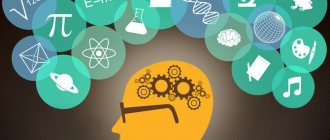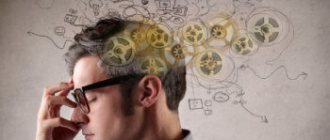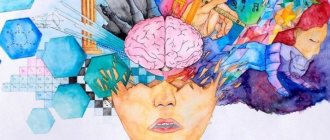- Figurative memory
- Visual memory
- Auditory memory
- Motor memory
- Verbal-logical memory
- Emotional memory Functions of emotional memory
- Features of random memory
Human memory is, in fact, an interconnected process consisting of three components: input of information (memorization), its retention (storage) and, finally, reproduction. Their relationship is expressed in the fact that the preservation of information depends on how memorization is organized, and the quality of reproduction depends on it.
This circumstance should be taken into account when deciding for yourself the problem of how to improve soldering for an adult. Based on the nature of mental activity, they distinguish between figurative, verbal-logical, motor and emotional memory.
What is visual memory?
Visual memory, like memory in general, is a complex multi-vector phenomenon.
Thanks to memory, a person is able to build a picture of the world around him in his mind and determine his place in it. This article is devoted to one of the components of memory - visual memory. The term “visual memory” is self-explanatory. This is a visual memory of what we have already seen once. There are two types of visual memory: short-term and long-term.
Short-term visual memory.
This type of memory allows you to remember what a person recently saw and mentally recreate a living picture in your brain. Short-term visual memory is used in life literally at every step. For example, an artist looks at a certain object and immediately displays it on canvas; If a person needs to rewrite a text, he first remembers it and then transfers it to paper; If a person needs to know what time it is, he looks at his watch and remembers its readings for a few seconds after that.
A man waiting checks the time. Source: Pixabay.com
And there are a lot of such situations in life that require short-term visual memory. Memory cannot hold current information forever and periodically resets it, because after a few moments it becomes outdated, and memory needs space for new events entering it. However, if a situation is repeated over and over again, or it carries a special sensory load, then the accompanying visual image moves to the sector of long-term memory.
Long-term visual memory
It allows a person to recall a visual picture from his ancient past. As a rule, images associated with strong emotional experiences settle deeply in the memory and remain in it for many years. This especially applies to childhood memories, which a person is able to experience in the most vivid colors again and again even after many decades.
Repeated observations are also loaded into long-term memory. For example, trips to the same place allow you to become familiar with the route in detail, and this makes it possible to refuse to use a navigator or map. In this case, the entire road becomes a long colorful panel in the long-term memory, and along the way a person is able to anticipate the beauty of nature somewhere around the next turn.
The usual route does not require hints. Source: jill111 (pixabay.com)
This visual memory is especially developed among professional drivers. Many of them are able to travel along the route just once and remember it for a long time, when the need to travel to the same places arises again.
By the nature of mental activity
Depending on what mental activity predominates in human activity during the recording and reproduction of information, there are the following types of memory.
Motor
Other names: motor.
Definition in psychology: fixation, retention and reproduction of motor algorithms, their amplitude, duration, speed, direction. It is formed in a part of the brain called the reticular activating system.
Why is it needed: contributes to the development of a number of skills (domestic, sports, labor), as well as learning to write.
Examples:
- the simplest movements that a person learns from childhood: how to walk, hold a spoon, brush your teeth, comb your hair;
- playing tennis, team sports, swimming, gymnastics, aerobics, exercise equipment;
- knitting, embroidery;
- cutting food, peeling vegetables and fruits;
- drawing, modeling, wood carving;
- dancing;
- playing musical instruments.
Who is especially well developed: athletes, secretaries, dancers, jewelers, watchmakers, surgeons, assembly line workers.
Development methods:
- Exercise. Master different sets of exercises.
- Develop fine motor skills (sculpt, assemble puzzles and Legos).
- To take dance classes. Learn new directions.
- Develop your hands.
- Learn to play musical instruments.
- Master the ten-finger touch typing method.
- Learn to use Chinese chopsticks.
- Perform exercises that involve completely different movements with your hands (for example, the left hand strokes the table in a circular motion, and the right hand, clenched into a fist, knocks on the table).
Emotional
Definition in psychology: fixation, retention and reproduction of feelings experienced by a person, as well as emotionally charged events. They can be positive and negative. They are formed by a part of the temporal part of the brain called the amygdala. They are deposited in the cerebral cortex. Thanks to the plasticity of the central nervous system, with each subsequent reproduction of the same situation, its brightness is smoothed out.
Why is it needed: feelings experienced and recorded by emotional memory become a kind of signaling system for a person. It either encourages him to act (if the experience was positive) or deters him from it (if the experience was negative). Forms a versatile personality, develops emotional intelligence, promotes social adaptation, and stimulates creativity.
Examples:
- empathy, sympathy (based on experience);
- Love;
- complexes;
- phobias;
- choice of social circle (people move away from those who hurt them in the past).
Who is especially well developed: actors (the famous system of K. S. Stanislavsky is based on it), teachers, psychologists, representatives of social professions.
Development methods:
- Keeping a diary.
- Meditation.
- “Anchoring” positive feelings and emotions.
- Bibliotherapy.
- Master networking and make as many new acquaintances as possible.
- Do what you like.
- Adrenaline: ride a roller coaster, jump from a parachute.
This is interesting. Psychologists say that a person remembers 3 feelings best - fear, suffering, surprise.
Semantic
Other names: verbal, logical, verbal-logical.
Definition in psychology: fixation, retention and reproduction by a person of heard, seen, spoken words.
Why is it needed: allows you to record and reproduce information based on generalized associations that reflect its most important aspects. Uses large structural units for memorization, which are called mnemonic supports. After a while, they are the ones who help a person remember the material.
Examples:
- retelling;
- memorizing poems;
- preparation for exams.
Who is especially well developed: artists, singers, pupils, students.
Development methods:
- Break information into blocks and isolate main ideas.
- Read complex texts every day that are far from your interests, try to understand and remember the information contained in them.
- Before going to bed, remember in detail the past day (week, month, quarter, six months, year).
Figurative
Other names: visual-figurative.
Definition in psychology: fixation, retention and reproduction of visual and sound images, as well as odors.
Why is it needed: to control the balance of functioning of both hemispheres of the brain.
Subtypes:
Who is especially well developed: musicians, artists, writers.
Development methods:
- Master the association method.
- Do neuroscience.
- Learn foreign languages.
This classification is considered basic in psychology. Particular attention is paid to the figurative type.
Related article: How to develop memory
Visual memory and learning
Visual memory is especially important in the field of learning. Up to 80 percent of all information that a person receives from the outside during the learning process consists of visual images. This primarily concerns the processes of reading and writing.
When a person learns to read, he remembers the images of words that he sees. When he learns to write, he remembers what each letter and the word as a whole looks like. And when he learns to type, he first needs to look at the keyboard to find the right letter on it. As you work with the keyboard, a visual image of it is developed in memory, and the person already subconsciously knows where each letter, number or symbol is located.
Figurative memory
Figurative memory is a repository of sounds, smells, and visual ideas. Visual-figurative memory stores material in the form of visual, auditory and other images. Therefore, several separate types of figurative memory are distinguished, such as auditory (try to remember the purring of a kitten or the crackling of brushes in a fire), visual figurative memory (the face of a loved one or a favorite vase - remember?), olfactory (the smell of a familiar perfume or just freshly cut grass), tactile (the touch of a warm hand or the pain of an injection), taste (the sourness of a slice of lemon or the sweetness of a banana). Visual-figurative memory is especially important in creative activity.
Our brain prefers to perceive the world by processing information in both hemispheres: the right one perceives the image, and the left one selects words for it. By developing figurative memory, we fill the gap caused by the lack of images: in the modern world there is a lot of information, but the bulk of it does not involve the right hemisphere in its work, an imbalance arises, as a result of which it is increasingly difficult for us to remember, maintain attention, and concentrate. The development of figurative memory helps to engage the right hemisphere, using the imagination. By imagining, we remember easily. Having understood the material, we create an image that consolidates understanding and gain knowledge.
There are visual, auditory, motor-auditory memory, visual-motor-auditory memory. These are the types of so-called sensory memory that play the most important role in learning. Knowing what type of memory predominates in a student, you can take a differentiated approach to the process of his learning, achieving better memorization results. The teacher must ensure that as many senses as possible participate in the process of learning the material. At one time, the famous teacher K.D. drew attention to this. Ushinsky.
Signs of undeveloped visual memory
Unfortunately, nature has not endowed everyone with the ability to remember visual images well. Many people have problems with visual memory. They can be expressed as follows:
- Poor reading comprehension, when parallel reading of the text is required.
- Lots of spelling errors.
- Difficulty with arithmetic and using a calculator.
- Problems with writing words and displaying any visual images.
- Difficulty recognizing letters and numbers.
- Slow text writing and jumbled letters.
To compensate for these deficiencies, people with poor visual memory may use other forms of memory. Some use auditory memory, which is expressed in “sounding out letters.” For example, when writing a text, a person can whisper words to himself.
Trying to write out loud. Source: Raphael Jeanneret (pixabay.com)
This makes it easier for him to cope with his task. However, auditory memory is not as effective as visual memory and cannot fully replace it. On the contrary, poor auditory memory is well corrected by visual memory. No wonder there is a saying: “It is better to see once than to hear a hundred times.”
Features of visual memory
Functionally, visual memory has the character of spatial perception and fixation. She seems to record the surrounding space within herself. However, the whole is broken into fragments. In other words, individual objects in the form of images stand out from the overall picture. They are processed by the brain and stored in memory. There can be many such images; the overall picture consists of them, like a mosaic panel. At the same time, the brain continues its work: it analyzes particulars and composes them into a whole.
In addition, visual memory, together with the computing capabilities of the brain, allows a person to create in his head not a flat, but a three-dimensional visual image and manipulate it as desired, viewing an abstract object that exists only in the imagination, from a variety of angles of view.
Here it is appropriate to mention the so-called sequential visual memory, which is an integral part of visual working memory, since it involves the ability to recall elements or objects in their correct sequence. With a deficiency of such memory, a person makes many spelling mistakes in writing, has difficulty remembering telephone numbers, and in general, he has problems with reproducing any visual sequence.
Development methods
There are many ways to develop visual memory. Even simple tests like “Find 10 differences” are excellent for stimulating the brain. To develop memory, numerous techniques are used to stimulate abilities, for example, drawing from memory, describing a picture or photograph after looking at it for a short time, and an exercise to reproduce surrounding objects.
They come up with a simple, exciting task for children. On the way home from school, they remember everyone they meet and then describe it to their parents. Rewarding success will encourage intensive exploration of the world. The method improves children's attentiveness, helping to develop and improve skills.
For kids, describing pictures in children's books, sculpting figurines of pets from memory is suitable, and for older children - a card game to develop good visual memory.
To interest the baby, classes are made attractive for age and regular. Then the results will be impressive within a month after the start of training.
Visual memory of visualists
The development of visual memory is a way to accumulate and analyze visual images and emotions. This is especially true for artists, architects, designers and, in general, people associated with painting, sculpture, theatrical productions, television, advertising, the creation of three-dimensional architectural forms, various geometric structures, mechanisms, etc. and so on.
Fractal 3D design. Source: TheDigitalArtist (pixabay.com)
For example, for artists, after years of practice, the process of mental visualization may occur almost unconsciously every time they take up a brush, even when working with studies en plein air. Once back in the studio, they open up their visual library, so to speak, and draw from it for missing details of color, light, shape or line to bring their work to life. Therefore, it is not surprising that a work of art created in collaboration with visual memory is able to express emotions and attract the viewer more than just a plot painted from life.
Visual memory training
It is vital for artists to train their visual memory. And they have developed a whole system of techniques to help them do this. Some of them, before starting to draw, carefully study the image object or many of them, memorize proportions, colors, shapes, and mentally compile a general plot. After this, they retire to another room, where there is an easel with a canvas, and try to depict what they were able to remember. This can be repeated many times before a feeling of confidence appears in your hands and soul. Such skills are especially important for landscape painters, in whom the subject of the image changes every moment. In this case, the painter remembers the strongest emotional impression evoked in him by the image of nature, and draws it from memory. It is well known that the famous Russian marine painter I.K. Aivazovsky painted his striking paintings of the sea from memory, sitting in a curtained studio. And his works aroused delight among the public.
Lunar landscape with a ship. Artist I.A. Aivazovsky
Equally important is visual memory fluency for architects or structural engineers. Both of them deal with complex volumes that have yet to be born. For this reason, it is important for professionals to be able to imagine in their heads a 3D version of their future brainchild in all its variety of details and functions. An architect can imagine a whole street with a stream of cars or an alley with the rustling of leaves, and a designer can imagine the work of a complex mechanism, where all the parts are in interdependent motion.
Emotional memory
Emotional memory contains all memories of experienced emotions and feelings. A feature of emotional memory is its brightness even after many years after the emotional outburst received. Usually, supported by an emotional impulse, it stores information for a long time and firmly. This may be due to the fact that, under the influence of strong emotions, adrenal hormones are included in the memorization mechanism, which are not involved in normal memorization.
Sometimes primary emotions are replaced by secondary ones, sometimes opposite ones, and then we overestimate our attitude towards events that once took place.
The development of the emotional type of memory helps to increase a person’s intellectual potential. Both success and comfortable emotional state in the family and society depend on the development of emotional memory. Works of art, wildlife, and fiction stimulate the development of imaginative thinking, which also contributes to the development of emotional memory.
What is eidetic memory?
One of the types of visual memory is the so-called eidetic, or simply photographic, memory. From the name it is clear that such a memory allows its owner to recreate in his visual memories every detail, as in a photograph.
Eidetic - camera man
Essentially, eidetic memory is the brain’s ability to remember large amounts of information in as much detail as possible in a very short period of time. A person with such visual memory in one quick reading is able, for example, to memorize a poem by A.S. Pushkin “Eugene Onegin” or a map of a large city with all the streets, alleys, transport routes, traffic lights, etc. This type of memory is very useful for theater and film artists, who have to memorize huge amounts of text as part of their work.
Eidetic memory is characterized by an amazing ability to remember numbers, words or visual images, but sometimes a person with such a gift in one area will be completely helpless in some other areas. In addition, this phenomenon also has its downside: many scientists consider eidetic memory as a serious mental deviation. Thus, doctors claim that innate eidetic memory is a pathology associated in many cases with serious diseases: autism, epilepsy, dementia, savantism, schizophrenia, hallucinosis, etc.
An example of a living eidetic
Here is one of the most striking examples of the real use of eidetic memory. Drawing entire metropolises from horizon to horizon is exactly what autistic contemporary British artist Stephen Wiltshire does for a living.
British artist Stephen Wiltshire draws from memory. Source kazned.ru
He does this from memory, having flown only once in a helicopter over any huge city, after which he sits down in a hall filled with spectators in front of a huge panorama canvas and draws out the entire city live, step by step, down to the smallest detail. Moreover, what is drawn absolutely coincides with reality. But, paradoxically, in life an artist is capable of getting lost in the city he has just drawn and going in the exact opposite direction from the desired route.
Memory classification
Psychology relies on the following criteria in identifying types of memory:
1. The nature of the predominant mental activity:
- motor,
- figurative,
- emotional,
- verbal-logical.
2. Nature of activity goals:
- free
- involuntary.
3. Duration of fixing/preserving material:
- short-term,
- long-term,
- operational.
4. Use of mnemonic devices:
- direct,
- mediated.
Which of the greats had eidetic memory?
Many great people have had the gift of eidetic memory. This helped them keep in mind, combine and analyze a huge variety of different information in the areas of activity in which they were engaged. This quality was extremely useful in an era when personal computers did not yet exist. Here are just a few of these people:
Sergei Rachmaninov, Russian composer and pianist. Having once looked at unfamiliar notes, he could immediately play any complex musical composition with absolute precision.
Nikola Tesla, electrical physicist. I never used notes because I kept everything in my memory.
John Paul II, Pope. Fluent in 21 languages.
Seneca, Roman philosopher. In exact sequence, he recalled from memory two thousand words he read, often not even related in meaning.
Winston Churchill, British politician. Knew all of Shakespeare by heart.
Heinrich Schliemann, archaeologist. I studied any foreign language in a month and a half.
Paul Morphy, chess player. He remembered all the moves of the games he played.
Daniel Tammet. Able to name more than 22 thousand decimal π
Alexander Suvorov, Russian commander. He knew by sight and name every soldier in his army, which consisted of 24 thousand people.
Hyperthymesia, or autobiographical memory
There is another form of hypertrophied memory. This is the so-called autobiographical memory, or scientifically hyperthymesia. This state of memory is characterized by a person’s ability to remember any day of his life with extreme clarity, consistency and detail. He is able to tell in great detail what the morning was like on a specified day exactly ten, twenty or thirty years ago, describe the people with whom he communicated then, tell the topics of the newspapers he read, recall the verbatim content of his telephone conversations, etc. and so on. The brain of such people works like a computer.
Hyperthymesia is a brain-computer. Posted by CreativeCar (pixabay.com)
It’s as if a person is replaying a whole movie in his memory with all the visual details. Moreover, he sees it in a three-dimensional image with a play of colors and shapes, accompanied by the surrounding polyphony of the world, with the feeling on his face of gusts of wind and even flowing smells. Modern cinema has never dreamed of such a thing. A prominent representative of this cohort of people is Marilu Henner, an American actress. She is able to tell in the smallest detail any fragment from her life, starting, according to her, from infancy. Fortunately, she is alive and well to this day.
Hyperthymesia is a real punishment
At the same time, the memory of such people accumulates a lot of negative life that they had to endure, and they are not able to get rid of it. If an ordinary person, in order to protect the nervous system, quickly forgets troubles, then in people with hyperthymesia, the memory forever immurs everything within itself. This makes the lives of such people very difficult. True, there are very few of them - literally only a few in the whole world.
How to improve your visual memory?
People who feel that their visual memory is not good enough often complain that they cannot remember other people's names or faces. They also have difficulty remembering travel routes or words from a book, even if they have just read them. Naturally, they would like to improve their visual memory. This is achieved mainly by training.
Parallel layout of items
One of the methods is to use two completely identical sets of any objects placed in different rooms for training. The essence is this: a person, being in the same room, lays out objects from the first set on the table in a completely random order. After this, he carefully examines the result, analyzes it and tries to remember: what, where and how it is located. Then he turns away and waits for a few minutes, continuing to hold the composition in his memory.
The simplest set of objects for training visual memory. Source: stevepb (pixabay.com)
After waiting, he goes to another room, where he has exactly the same set of objects. Now the person’s task is to recreate from the items of the second set his primary composition remaining in the first room. When everything is ready, you need to take a photo and compare the results. By repeating a similar technique many times, it is quite possible to train your visual memory to correctly record the plot and recreate it more and more accurately.
Connecting the 3D function
The second, more advanced, method is training large-scale visual memory. To do this, you need to select an object, for example, your mobile phone, and remember its appearance from all sides in as much detail as possible. After this, close your eyes and try to recall the image of the phone from your memory. It may not work out right away. But, as soon as it starts to work out, the next step is to try to mentally turn the phone sideways or backside. Attempts are also repeated many times.
It's similar to 3D computer games. When your attempts are successful, you can imagine the face of your interlocutor on the display and also mentally rotate the phone. If this works, then you can add his voice to the picture and even mentally construct a conversation. Approximately at this level, a person sees his dreams, only they come to him from the world of the unconscious, and here they should be caused by consciousness, extracting images from the storehouses of visual memory.
PS
Nature has laid in each of us approximately the same mechanism of life. Each has the rudiments of any talents characteristic of others. The task is only to reveal them. Naturally, if there is a desire, predisposition or need for this.
